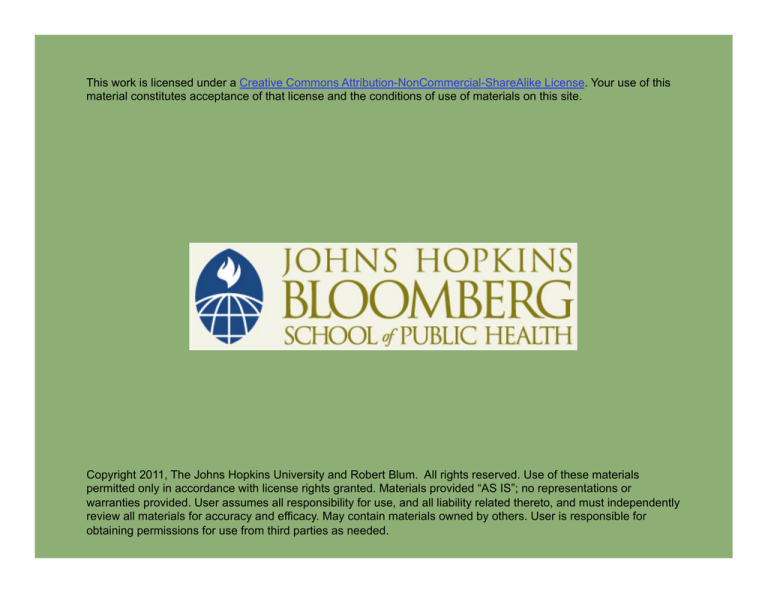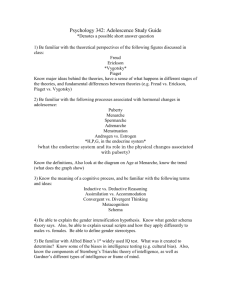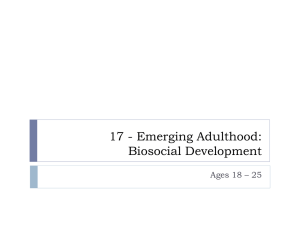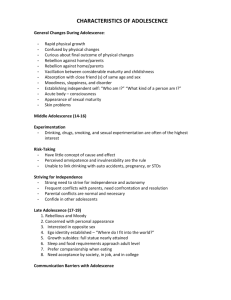
This work is licensed under a Creative Commons Attribution-NonCommercial-ShareAlike License. Your use of this
material constitutes acceptance of that license and the conditions of use of materials on this site.
Copyright 2011, The Johns Hopkins University and Robert Blum. All rights reserved. Use of these materials
permitted only in accordance with license rights granted. Materials provided “AS IS”; no representations or
warranties provided. User assumes all responsibility for use, and all liability related thereto, and must independently
review all materials for accuracy and efficacy. May contain materials owned by others. User is responsible for
obtaining permissions for use from third parties as needed.
Adolescent Brain Development
Robert Wm. Blum, MD, MPH, PhD
Johns Hopkins University
Section A
Factors That Contribute to Brain Maturation
Adolescence: Time for Great Risk and Opportunity
It is the stage of life of the greatest risk for:
- Emergence of psychological disorders
- Depression, anxiety, conduct disorders (early/mid adolescence)
- Schizophrenia (late adolescence)
- Alcohol and drug use (mid/late adolescence)
4
Culture Influences the Timing of Puberty
Monogamous vs. polygamous societies
Presence vs. absence of father
Exposure to pressures
5
Some Developmental Phenomena Occur Cross-Species
Earlier maturation of females
Greater risk taking of males
Change in sleeping patterns
Increased alcohol consumption
6
Epigenetics
Genes and environment interact through epigenetic processes to
influence behavior
7
How Epigenetics Works
Epigenetics controls genetic influence through methylation (-CH3
group) to one of the proteins in DNA sequence, effectively silencing
the gene
- Genes surrounded by methyl groups are more difficult to
transcribe or copy
8
Example
The role of licking of rat pups by mother in infancy influences
degree of aggressiveness when they mature (Weaver et al., 2004)
9
Genetic Influences on Behaviors
Genetic influences on behaviors tend to increase with age through
adolescence
Verbal skills and cognitive functioning of adopted children become
increasingly more like biologic than adoptive parents during
adolescence
10
Genetic Differences in Brain Development
Female is the “default” pathway for neurodevelopment
Absent of testosterone, female brain development occurs with
syndromes
- Congenital adrenal hyperplasia
- Androgenetic sensitivity syndrome
11
Sexual Orientation
Pre- and post-natal hormonal environment of the brain may
influence sexual orientation
- Congenital adrenal hyperplasia
- Diethylstilbestrol (DES)
- Maternal stress
- Genetics
12
Critical Periods for Male-Typical Sexual Differentiation
Perinatal: gonadal hormones influence sexual differentiation of the
brain
Puberty: rising hormonal levels produce final maturational changes
of the brain
13
Rising Sex Hormones Influence Sexual Interest
Church Going
Testosterone
Source: Urdy, 1985
High
Low
High
2
4
Low
1
3
14
Raging Hormones Is a Myth
Hormones contribute only modestly to adolescent mood
Contributions to negative affect
- Gonadal hormones: 4%
- Social factors: 8–18%
Testosterone contributes modestly to male risk-taking
15






